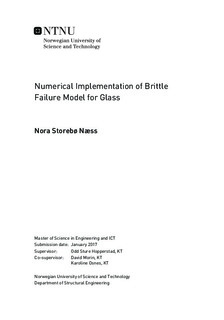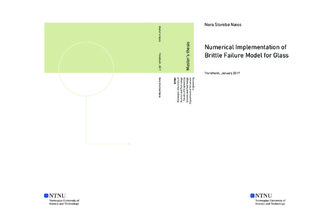| dc.description.abstract | This thesis is concerned with a strength model for float glass. Failure of glass is usually initiated from surface flaws and the glass is reckoned as failed with the first failing flaw. The model implements a flaw map over the glass surface of arbitrary orientations and flaw lengths of maximum 200 μm. Every flaw is checked for failure for an applied load until the critical load for the first failing flaw is found through a search method. The plate geometry is applied several flaw maps for a Monte Carlo analysis, resulting in a probability distribution for strength. This means that rather than assuming the probability distribution a priori which requires parameters obtained from experimental test series, as is done for the traditional probabilistic strength model Weibull distribution, it is generated from the analysis. Additionally, the model provides information about fracture origin in the glass plate.
An analytical solution of the model was implemented in MATLAB, and verified with data from Abaqus FEA. Then the model was implemented in an Abaqus post-processing Python script and further verified by comparing with the analytical solution. The verification processes yielded satisfying results and the model is assumed to be working according to the mathematical foundation. Additionally the flaw map property of the model was applied to an Abaqus VUSDLFD subroutine, exploring visualization of failing flaws.
The model was subjected to parameter studies examining the model response from different plate and flaw geometries, yielding reasonable results. The resulting distributions were compared with fitted Normal and Weibull distributions, and in most cases the Weibull distribution provided the best fit. The Weibull modulus from the fitted Weibull distributions varied for plates with different numbers of flaws, suggesting it is inaccurate to assume this parameter as a material constant. Further, case studies comparing the model behavior to experimental results from four point bending tests were performed. In addition the model behavior were examined under the influence of blast loads. The studies disclosed the notable potential of the model. Finally, suggestions for further work with the model and the software in this thesis were presented. | en |

